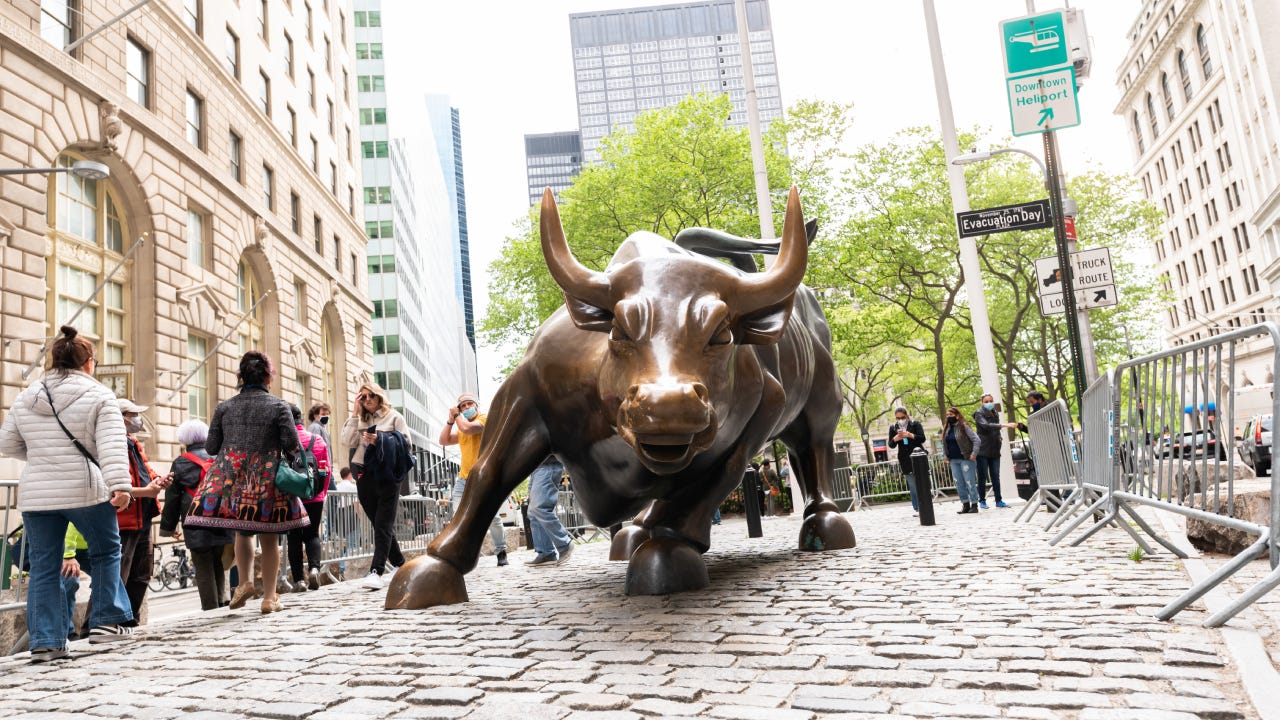What is a bull market and what does it mean for investors?

A bull market occurs when asset prices rise significantly over a sustained period. While analysts often use the term “bull market” to discuss stocks and the stock market, the term can be used for any asset – bonds, real estate, commodities or even cryptocurrency – that is rising over time. Some analysts define a bull market as one which has risen 20 percent from its most recent low.
Markets tend to go through periods of boom and bust known as bull markets and bear markets, respectively. The length of a bull market can vary widely, with some lasting just a few months, while others may last years. Here’s what a bull market is and how it works.
What is a bull market?
A bull market is a period of rising prices, particularly one where the rise is sustained over time, often with a stock or other asset repeatedly setting new highs. A bull market can refer to the price action on a single security or for a specific market as a whole. For example, experts might discuss a bull market for Apple stock or for bellwether indexes such as the Standard & Poor’s 500 or the Dow Jones Industrial Average, both of which are collections of stocks.
A bull market often signals the end of a bear market, a period of declining prices, though the turn to a bull market can only be judged in retrospect, when the shift is clear. The market may meander sideways for a long time before it ultimately decides to move higher and become a bull market.
Bull markets typically occur with a growing economy, as rising corporate profits translate into rising stock prices. Higher profits and the expectation of still-higher profits can fuel investors’ expectations, causing them to bid up asset prices as long as the future looks bright.
Bull markets often end with asset prices rising so fast and furiously that they end up in a bubble, with prices way out of connection with fundamentals. Asset prices may then fall as part of a market crash, an abrupt period of often just a few days when prices fall quickly. The crash may lead to a more forceful downturn and, ultimately, to the sustained downturn of a bear market.
Example of a bull market
The stock market has experienced many bull markets over the years. For example, stocks entered a bull market in March 2009, amid the Great Recession, and lasted until COVID-19 effectively shut down the world economy in March 2020. Then, with the help of massive fiscal and monetary stimulus, a new bull market emerged. This second bull market for stocks lasted until December 2021, when the S&P 500 peaked, and then ultimately turned into a bear market, as the Federal Reserve announced it would raise interest rates and then rapidly did so in 2022.
Characteristics of a bull market
While each bull market may be driven by different factors, they tend to have similar traits:
- Significant price growth: The most defining characteristic of bull markets is sustained growth in asset prices, with a single asset or an index setting new highs repeatedly over a period of time.
- High investor confidence: Investors usually feel good when the market is doing well. This means they are more enthusiastic about investing and might even consider more speculative or risky investments. These “animal spirits” push up asset prices further.
- Declining unemployment rate: Bull markets are often marked by a declining or low unemployment, and as people have money to spend, they drive corporate profits higher.
- Growing economy: Bull markets also tend to coincide with periods when the economy is growing, including positive signs among key economic indicators. Often a bull market will kick off before an economy is fully out of a recession and will end before it’s clear that the market is entering a recession or other downturn.
Bull market vs. bear market
In many ways, bull markets and bear markets are opposites. Although some exceptions exist, trends tend to move in the opposite direction in each scenario. Here is how the two markets compare:
| Bull market | Bear market | |
|---|---|---|
| Performance | Asset prices rising to new highs consistently | Asset prices down 20 percent from recent high |
| Economic indicators |
|
|
| Average lifetime* | 5.3 years (since 1943) | 12 months (since 1946) |
| Frequency* | 6.1 years (since 1943) | 5.8 years (since 1946) |
| Average return* | 169.5 percent (for bull markets between 1943 and 2021) | -33.6 percent (for bear markets between 1945 and 2021) |
* Source: Yardeni Research
Here’s how to invest in bullish and bearish markets.
How to invest in a bull market
Bull markets are tough to predict, and analysts usually only recognize them after they have happened. As a result, it tends to be difficult to be a trader around bull markets, and instead it makes sense for investors to think and invest longer term rather than try to trade in and out.
For most investors, it’s best to develop a long-term strategy and stick to it regardless of market conditions. For example, you might invest the same amount at regular intervals, using the popular investing strategy called dollar-cost averaging. Because you always invest regardless of market conditions, sometimes you’ll be buying at relatively cheaper prices.
Here are some investing tips to consider in bull markets, though they work well in bear markets, too:
- Develop a long-term strategy and then stick to it. Determine what investment strategy works for you and stick to it. If you’re looking for minimal effort and solid returns, buying an S&P 500 index fund and holding it for years has worked great for many investors. But if you try to actively trade it, odds are that you’ll massively underperform.
- Add money to the market over time. Adding money to your portfolio regularly reduces the risk that you buy at a too-high price. It also maintains your investing discipline and helps you buy when prices may be down a bit, setting you up for better long-term gains.
- Adjust your strategy to meet your needs at key points. As you get closer to retirement, you’ll be less able to ride out periods of poor market performance, because you’ll need to start tapping your money. So it can make sense to reduce your portfolio’s risk over time.
- Invest in low-cost index funds. Low-cost index funds have several advantages, the biggest of which are low fees and easy diversification. But if you buy and hold them, you can avoid costly taxes, and the best index funds offer attractive returns.
- Keep your emotions in check. It can be easy to get excited when your investments rise, especially if they do so quickly. That might lead you to invest more money than you ought to or to overestimate your investing skill. Setting up a regular investing plan can help take your emotions out of the process, helping you buy when stocks are down but also from buying too much when they’re rising quickly.
Bottom line
A bull market is a period of significant growth, and major stock indexes are typically used to measure bull markets, but the term can also refer to the growth of individual securities. Bull markets tend to last longer than bear markets and deliver returns that more than offset the losses in bear markets. So most investors should stick to a long-term investing strategy, and avoid trying to outguess the market as a short-term trader – or risk severely underperforming.
You may also like

What are homeowners insurance premiums and how do they work?





